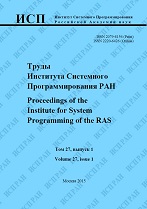|
This article is cited in 5 scientific papers (total in 5 papers)
Modern approaches to aspect-based sentiment analysis
I. Andrianova, V. Mayorova, D. Turdakovabc
a Institute for System Programming of the RAS
b Lomonosov Moscow State University
c National Research University "Higher School of Economics" (HSE)
Abstract:
The paper presents a survey of methods solving the actual task of aspect-based sentiment analysis. Solutions for this task were proposed at multiple natural language processing conferences. Organizers of these conferences proposed evaluation platforms for methods for aspect-based sentiment analysis. This paper describes methods proposed by participants of two international evaluation platforms: SemEval-2015 focusing on English texts and SentiRuEval-2015 focusing on Russian texts.
SemEval-2015 organizers provided participants with the task 12.2 for English language and two domains: restaurants and laptops. The task was split to multiple subtasks two of which are described in this paper: opinion target expression (both explicit and implicit ones) extraction and sentiment polarity detection. Described methods for opinion target expression can be split to the following categories: sequence labeling, domain-specific terminology extraction and unsupervised learning. Methods for sentiment polarity detection varied from classification-based to unsupervised learning.
SentiRuEval-2015 organizers provided participants with the tasks A, B and C for Russian language and two domains: restaurants and automobiles. Task A was devoted to explicit aspect term extraction, task B – to explicit, implicit and factual aspect term extraction. Sentiment polarity detection was subject of the Task C. Described methods for aspect term extraction can be classified as following: sequence labeling, word2vec-based and neural network-based. Methods for sentiment polarity detection varied from word2vec-based to neural network-based.
Keywords:
sentiment analysis, aspect extraction, text processing, machine learning.
Citation:
I. Andrianov, V. Mayorov, D. Turdakov, “Modern approaches to aspect-based sentiment analysis”, Proceedings of ISP RAS, 27:5 (2015), 5–22
Linking options:
https://www.mathnet.ru/eng/tisp169 https://www.mathnet.ru/eng/tisp/v27/i5/p5
|

| Statistics & downloads: |
| Abstract page: | 242 | | Full-text PDF : | 112 | | References: | 51 |
|




 Contact us:
Contact us: Terms of Use
Terms of Use
 Registration to the website
Registration to the website Logotypes
Logotypes








 Citation in format
Citation in format 
